
Etruscan Phrases
Translation of Short Inscriptions (continued)
Mirrors from the Corpus Speculorum
Etruscorum*
Scripts: CAA, CB, CC, CD, CF, CG, CE, CH, CI, CJ,
CL,
CK, CN, CM, CO, CQ, CR, CS, CT, CU, CV, CX, CZ,
CAB, CY, CAC
by
Mel Copeland
(from a work published in 1981)

|
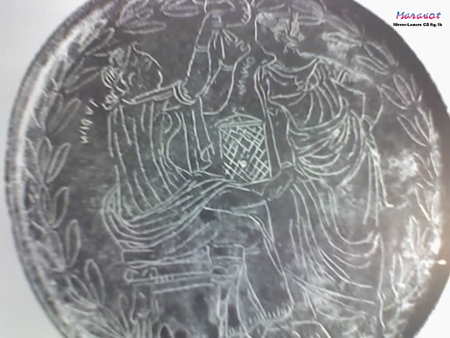 |
|||||||||||||||||||||||||||||||||||||||||||||||||||||
| Script
CAA — Corpus
Denmark, Fasccule 1, by Helle Salskov
Roberts, The Danish National Museum, the Ny
Carlsberg Glypothek, Odense University
Press, 1981, fig. 21a, from a tomb near
Tarquinia. CAA-1 HERCLE MALAFIS CAA-3 ARTVME or ARTVMS, ARTVMEI, APLV [Translation: Artemis of Apollo] Note: the spelling of APVLV at Script CD. The young man being dressed by Apollo could be Melampus, perhaps the greatest Greek seer, who became a seer after meeting Apollo beside the river Alpheius. The spelling of the names of Artemis and Apollo is a variant. I have found no record of Artemis and Heracles being involved with Melampus. |
Script
CB — France
1, Fasicule III "Turan and Ralna" (text
refers to her as Thalna). Note: Ralna is the
consort of Tinia in the Divine_Mirror.html,
Script DM CB-1 TVRAN [Aphrodite] CB-2 RALNA [Nemesis, consort of Tinia (Gr. Zeus) that gave birth to the egg that became Helen of Troy] |
|||||||||||||||||||||||||||||||||||||||||||||||||||||
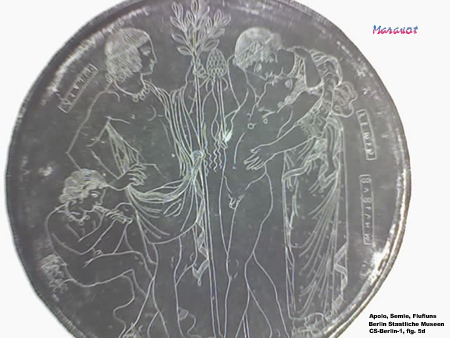 |
||||||||||||||||||||||||||||||||||||||||||||||||||||||
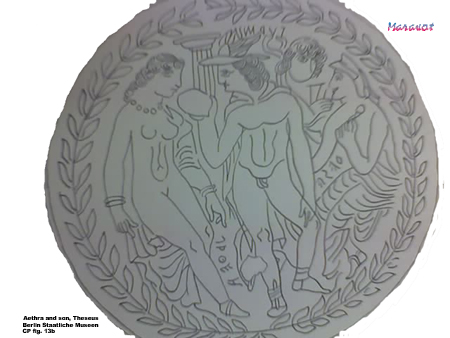 |
||||||||||||||||||||||||||||||||||||||||||||||||||||||
| Script
CD —
Deutche Demokratishche Republik, Faszikel I,
Berlin Staatliche Museum Antikensammlung,
1986, Akademie-Verlag, Berlin CD-1 APVLV (Apollo) CD-2 SEMLE (Semele) CD-3 FUFLUNS (8V8LVNS) [Semele was the mother of Dionysus whom the Etruscans called Fufluns. This story has been described elsewhere in "Etruscan Phrases."] |
||||||||||||||||||||||||||||||||||||||||||||||||||||||
| Script
CC —
Deutche Demokratishche Republik, Faszikel I,
Berlin Staatliche Museum Antikensammlung,
1986, Akademie-Verlag, Berlin CC-1 VRTHEA [Aethra, mother of Theseus. See story below] CC-2 THESE [Theseus] CC-3 TVRMS [Hermes] Aegeus, king of Athens, went to Delphi to ask advice about his childlessness. On his return journey, he stopped at the court of the wise king Pitheus, at Troezen, because he did not understand the answer that he had received from the oracle: that he should not loosen the foot (spout) of the wineskin until he reached Athens. Pittheus grasped the meaning at once, but, instead of enlightening Aegeus, he made him drunk and arranged to have him lie with his daughter Aethra. The next day Aegeus left a sword and a pair of sandals beneath a heavy stone and instructed Aethra that, if she bore a son who one day proved strong enough to move the stone, she should send him with the tokens to Aegeus at Athens. Aegeus went on his way, unaware that in the same night the sea-god Poseidon had lain with Aethra. In due course a son was born to Aaethra, and she named him Theseus. By the age of sixteen the boy was extraordinarily strong, and clever as well, as might be expected of a yough whose great-grandfather was Pelops, whose grandfather was Pittheus, and whose father was either a king or a god. Evenb as a boy he had demonstrated this happy fusion of traits by converting the sort of wrestling from a mere text of strength to an art requiring quickness of wit and skill. Pittheus let it be understood that Theseus was a son of Poseidon, as indeed Theseus seems to have believed himself to be. Nevertheless, when Aethra showed the youth Aegeus' tokens and he lifted the stone with ease, Pittheus agreed that he should go to Athens. From childhood Theseus had listened with admiration and envy to tales of the labors of Heracles. Now he was determined to emulate him and make an enviable name for himself. |
||||||||||||||||||||||||||||||||||||||||||||||||||||||
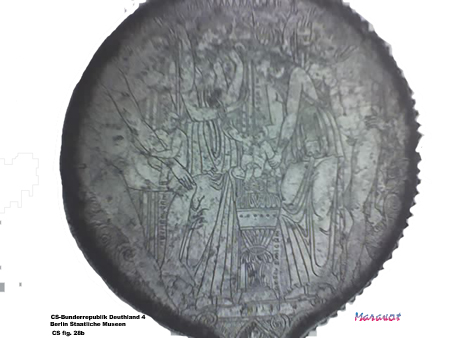 |
||||||||||||||||||||||||||||||||||||||||||||||||||||||
| Script
CF —
Deutche Demokratishche Republik, Faszikel I,
Berlin Staatliche Museum Antikensammlung,
1986, Akademie-Verlag, Berlin, from Chiusi,
1848, Figure 28b. CF-1 MARIS HVSR NANA [Translation: Mars (L. Mars, Martis, old form Mavors, god of agriculture and war) to raise (Fr. haut; hausser, to raise, lift) a funeral song ? (L. naenia [nenia-ae]; It. nenia)] CF-4 MENRFA [Minerva] CF-5 LEINR MARIS HAVSA [Translation: Larentia? (See CZ-1) Mars she empties, draws out (L. haurio, haurire) ] Note: See CZ, "Mean crowning Heracles," where LEINR or LEINTH is a person and appears to be the goddess Larentia, the most beautiful prostitute of Rome, who serviced Heracles. CF-8 RECIA Le [Translation: Recia, name? Le, there (Fr. le, la)] The name, Recia, may refer to the child being drawn up in the presence of what appears to be a giant or refers to L. regia-ae, palace, royal family; adv. regie, royally, tyranically. If this involves a child sacrifice the adv. tyranically seems to relate here. |
||||||||||||||||||||||||||||||||||||||||||||||||||||||
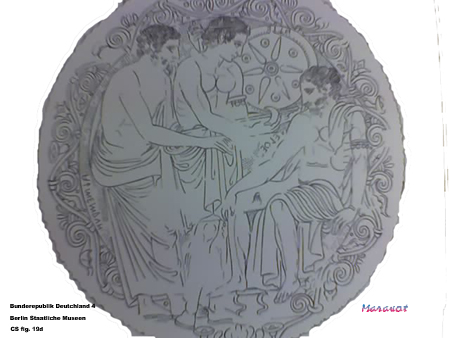 |
||||||||||||||||||||||||||||||||||||||||||||||||||||||
 |
||||||||||||||||||||||||||||||||||||||||||||||||||||||
| Script
CG — Bunderrepublik
Deutchland 4, Staatliche Museen Zu Berlin,
Antikensammlung 2, 1995, Hirmer Verlag,
Munchen. CG-1 ACHLE (A CG-2 FELRE? Note: The word FELRA and FELRE appears in Scripts TC and Z. CG-3 ACHMEMNVN (Agamemnon) Note: Agamemnon appears in the Divine_Mirror.html, Script DM. Phoenix and Odysseus were the ones that were in the embassy to persuade him to join the battle. |
||||||||||||||||||||||||||||||||||||||||||||||||||||||
| Script
CE —
Corpus Bunderrepublik Deutchland 4,
Staatliche Museen Zu Berlin, Antikensamlung
2, 1995, Hirmer Verlag, München, Figure 20b. CE-1 TINIA [Gr. Zeus, L. Jupiter] Note: "ia" suffix, gen. case. Uni's name does appear with "ia" sufix at AH-7, mirror of "Uni suckling Heracles." CE-2 VNI [Gr. Hera, L. Juno] |
||||||||||||||||||||||||||||||||||||||||||||||||||||||
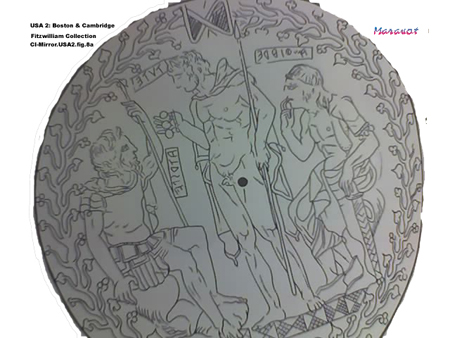 |
||||||||||||||||||||||||||||||||||||||||||||||||||||||
 |
||||||||||||||||||||||||||||||||||||||||||||||||||||||
| Script
CI —
Corpus Great Britain 2, Cambridge, The
Fitzwilliam Collection, Cambridge
University, fig. 8a. CI-1 AMPHIARE (AMØIARE) [See story below] CI-2 TVTE (Tydeus) CI-3 ATRSTE (Adrastus) Amphiaraüs was an Argive warrior and seer. In this mirror he seems to be divining before the seated King Adrastus. He was a son of Oicles and Hypermnestra and a descendant of Melampus and was the great diviner of his day. Loved by both Zeus and Apollo, he received his second sight from Zeus. Amphiaraus hunted the Calydonian boar and, some say, was second only after Atlanta in shooting it. He drove Adrastus from the Argive throne, but the quarrel was patched up. He married Adrastus' sister Eriphyle and agreed that she should thereafter act as arbiter between himself and Adrastus, each agreeing to abide by her decisions. When Oedipus died, Amphairaus helped to officiate at his funeral and was much admired by the Theban women. Later, knowing that only Adrastus would survive the campaign of the "Seven against Thebes," he at first refused to join it, but Eriphyle, bribed by Polyneices, forced him to go. Amphiaraüs made his sons, Alcmeon and Amphilochs, vow to avenge him. On the way to Thebes, Amphiaraus repeatedly warned of impending disaster, blaming Tydeus for fomenting the war. Nevertheless he was second only to Adrastus as a leader and may have surpassed him, He avenged himself on Tydeus by preventing his immortilization by Athena. Zeus saved the seer from the shame of being speared in the back by Periclymenus by splitting the earth with a thunderbolt. Amphiaraus, together with his chariot, charioteer, and horses, vanished forever. Amphiaraus was avenged on the Thebans and Eriphyle by Alcmeon. His daughter Demonassa married Thersander. |
||||||||||||||||||||||||||||||||||||||||||||||||||||||
| Script
CH —
Bunderrepublik Deutchland 4, Staatliche
Museen Zu Berlin, Antikensammlung 2, 1995,
Hirmer Verlag, München. CH-1 PENIA [Translation: Possibly Pandion, king of Athens, who was deposed by the mutinous sons of his uncle Metion. Pandion fled to Megara, where he married Pylia, daughter of King Pylas. This king killed his uncle Bias shortly thereafter and had to flee, leaving Pandion to succeed to the rule. The Illiad says Achilles had earlier sacked 13 Greek cities] CH-2 ACHL (A CH-3 LA (written on shield) This may be the other part of Achille's name, though his name is usually spelled ACHL, ACHLE. |
||||||||||||||||||||||||||||||||||||||||||||||||||||||
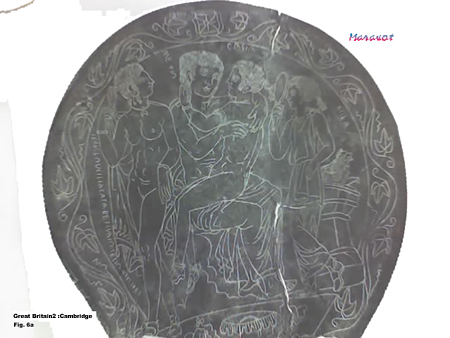 |
||||||||||||||||||||||||||||||||||||||||||||||||||||||
 |
||||||||||||||||||||||||||||||||||||||||||||||||||||||
| Script
CJ —
Corpus Great Britain 2, Cambridge, Corpus
Christie College, fig 6a, found at
Praeneste, 1872. CJ-1 FASIA ACILA [Translation: Fasia, name of boy, a maidservant, slave (L. ancilla-ae) CJ-3 METIN or METIA, name, probably Metion. CJ-4 CEISM Note: ATOS may be Actaeus, an early king of Attica, from whom some say Attica got its name. IONIO may be Ion, son of Creusa, daughter of Erechtheus, king of Athens, by either Xuthus or Apollo and is the father of the Ionians. METIN is probably Metion, son of Erechtheus. Erechtheus asked Xuthus, his son-in-law, to choose his successor, and Cecrops, the eldest son, was chosen. The other sons, Metion and Pandorus, were angry at being passed over and expelled Xuthus. LAVCILIA might be Lucilius, also the name of a Roman gens. |
||||||||||||||||||||||||||||||||||||||||||||||||||||||
| Script
CL —
Corpus Great Britain 2, Cambridge, Corpus
Christie College, Corpus Christie College
fig. 1a. CL-1 HERKLE PAKSTE or PAC ISTE [Translation: Heracles ; Pegasus?] Heracles was not involved with Pegasus, the winged horse used by Bellerophon. The horse, a male, pictured here is not winged. Heracles' labors involved the (8th labor) capture of the man-eating mares of Diomedes, (5th labor) cleaning the Augeian stables, (9th labor) fetching Hippolyte's belt, the Amazon queen's, and, possibly involving horses, (10th labor) the theft of the cattle of Geryon, king of Erytheia (now called Cadiz). If the words are PAC ISTE, we would read "I pacify, make fruitful" (L. paco-are) "that of yours" (L. iste, ista, istu) |
||||||||||||||||||||||||||||||||||||||||||||||||||||||
 |
||||||||||||||||||||||||||||||||||||||||||||||||||||||
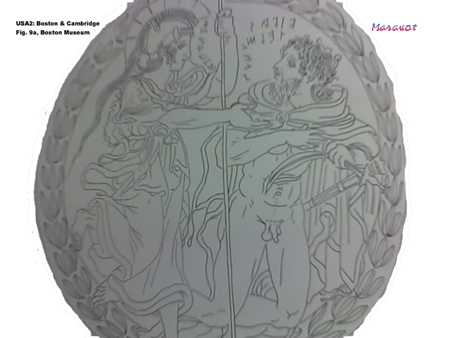 |
||||||||||||||||||||||||||||||||||||||||||||||||||||||
| Script
CK —
Corpus, Great Britain 2, Cambridge, Corpus
Christie College, figure 4. CK-1 MENRFA [Translation: Minerva] CK-2 ELCHSVNTRE (EL |
||||||||||||||||||||||||||||||||||||||||||||||||||||||
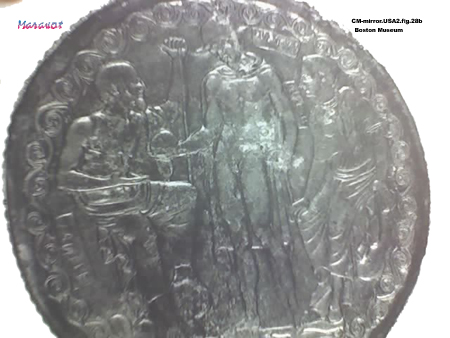 |
||||||||||||||||||||||||||||||||||||||||||||||||||||||
| Script
CN —
Corpus USA 2: Boston & Cambridge, Iowa
State University Press, 1993; Boston Museum
of Fine Arts, Cambridge-Harvard University
Museums, fig. 9a, Boston Museum, provenance
unknown. CN-1 EIFAS TELaMONOS (TELMVNVS) [Translation: Ajax [son] of Telamon] CN-3 – MENARFA [Etr. Minerva, Gr. Athena] Note: This is an important text since it identifies not only the specific Ajax – TELaMONOS – but also it provides a declension which follows the Greek declension. Telemon, son of Aeacus, king of Aegina, became king of Salamis. He had participated in the expedition of the Argonauts and the Calydonian Bear Hunt. He also was with Heracles when he stormed the ramparts of Troy and is also believed to have been in the war against the Amazons. There were two men named Ajax in the Trojan War. Ajax "the lesser" was a son of Oileus, a Locrian king, and recognized as a great spearman. Ajax, son of Telamon, was one of the largest and greatest warriors among the Greeks. He was named after the eagle. When Heracles prayed to Zeus to send a brave son to his friend Telamon, an eagle (Gr. aietos, L. aquila; avis-is, a bird of omen) appeared, signaling the god's assent. The son who was born was named Ajax (Aias) for the eagle. Ajax made his great reputation at the Trojan War, to which he led twelve ships from his father's island kingdom of Salamis. Taller by a head than the other Greeks and, next to Achilles, the handsomest of them, he was a bulwark on the field of battle. He fought most often side by side with Ajax of Locris, but his half-brother, Teucer, occasionally used his huge shield as a haven from behind which he could shoot arrows in safety. Ajax met Hector in single combat and they fought until the heralds parted them; afterward they exchanged gifts, Hector giving Ajax a sword in return for his belt. Ajax was the strongest defender of the Greek ships when they were threatened by a Trojan advance. He was a member of the embassy sent to plead with Achilles to rejoin the fighting, but, being a better soldier than speaker, he left most of the persuasion to Odysseus and Phoenix. He defended the corpse of Patroclus and, later, carried the dead Achilles from the field while Odysseus held back the Trojans. Ajax and Odysseus contested the right to be awarded Achilles' arms in recognition of their services to the Greek cause. Either with the aid of Athena or through some collusion with the judges, the eloquent Odysseus won the arms. Ajax was so distressed by this blow to his honor that he went mad and slaughtered the herds of the Greek forces, imagining them to be the leaders who had injured him. On recovering his senses, Ajax was overcome with shame and committed suicide with the sword that Hector had given him. At first Agamemnon and Menelaüs would not allow his body to be buried, but they relented; some say that a flower bearing the letters AI sprang up from his blood. "Ai" is an expression of grief, as well as a component of his name. Odysseus saw Ajax in the Underworld, according to Homer. |
||||||||||||||||||||||||||||||||||||||||||||||||||||||
| Script
CM —
Corpus USA 2: Boston & Cambridge, Iowa
State University Press, 1993; Boston Museum
of Fine Arts, Cambridge-Harvard University
Museums, fig. 28a and (as shown, 28b),
provenance unknown. This is an example of
stamped text in the bronze mirror, in
contrast to the usual incised text. The
stamped text would have allowed more mass
production, CM-1: LATFA, TVNTLE, TVRMS [Translation: Leda, Tyndareüs and Hermes] The scene depicted here is Herme's delivery of the egg containing Helen, produced by Nemesis who had changed into a goose to escape Zeus. Zeus changed into a swan and raped the goddess. The egg produced from the union was delivered to King Tyndareüs of Sparta and his wife, Leda, who raised Helen. Helen became queen of Sparta and was subsequently abducted by Paris of Troy. |
||||||||||||||||||||||||||||||||||||||||||||||||||||||
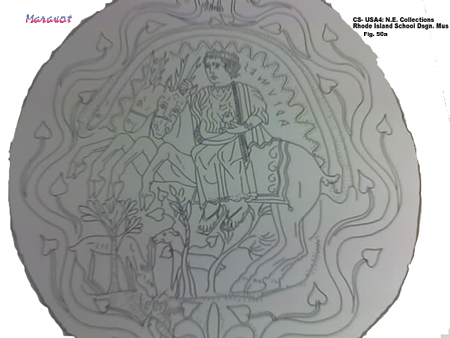 |
||||||||||||||||||||||||||||||||||||||||||||||||||||||
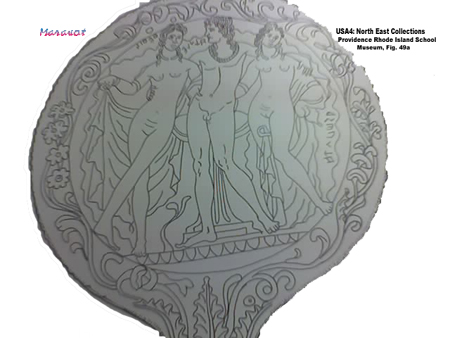 |
||||||||||||||||||||||||||||||||||||||||||||||||||||||
| Script
CO —
Corpus USA 4: N. E. Collections, Providence
Rhode Island, Rhode Island School of Design
Museum, fig. 50a, said to be from Orvieto. CO-1 ARTUMES (ARTVMES) [Translation: Artemis, virgin goddess of childbirth and of wild animals. Identified as Diana by the Romans and also seen as MAEN in the Divine_Mirror.html, Script DM, daughter of Zeus and Leto and sister of Apollo. Her arrows never missed their mark. Many attempted to violate her virginity, without success. On one occasion she was assaulted by the boisterous young giant Otus, while his brother, Ephialtes, pursued Hera. Apollo came to his sister's rescue by sending a deer between the brothers. Flinging their spears at it, they killed each other instead. Orion, too, tried to violate Artemis, according to some accounts, and was killed by her. Artemis was quite jealous of her honors. Agamemnon had boasted that he could hunt as well as she and in her fury she stalled the Greek fleet as it was heading towards Troy. She then demanded the sacrifice of Iphigeneia, Agamemnon's fairest daughter, but some say that a deer was substituted for the girl upon the altar and she was whisked away to the land of the barbaric Taurians to be their priestess there. She was an Asiatic goddess adopted by the Greeks and her temple in Epheseus (modern Ephes) was one of the Seven Wonders of the World. She was also associated with the moon, known as Phoebe. Britomartis and Dictynna were Cretan goddesses who were identified with Artemis, as was hecate on occasion. Here she is seen riding two horses. A famous statue shows her with several breasts. |
||||||||||||||||||||||||||||||||||||||||||||||||||||||
| Script CQ — Illustration of the mirror from Corpus USA 4, to the right>>> | ||||||||||||||||||||||||||||||||||||||||||||||||||||||
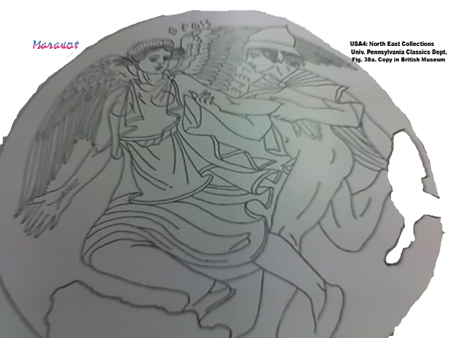 |
||||||||||||||||||||||||||||||||||||||||||||||||||||||
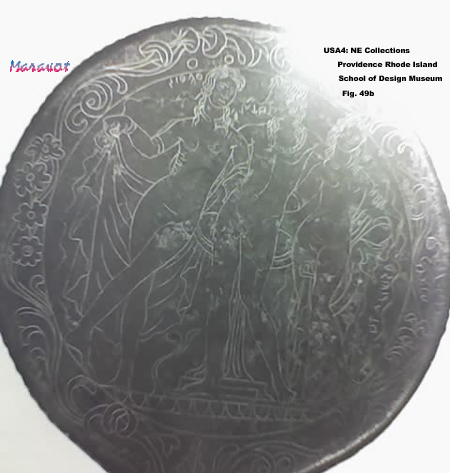 |
||||||||||||||||||||||||||||||||||||||||||||||||||||||
| Script
CR —
Corpus USA 4: N. E. Collections, Providence
Rhode Island, Rhode Island School of Design
Museum, figure 38a, said to be from the tomb
of Monte Torello, Fidenae. A copy of the
mirror is in the British Museum. CR-1 THETHIS ( CR-2 PELE [Translation: Peleus] Peleus was the husband of Thetis, and father of Achilles. He was the son of Aeacus, king of Aegina, and Endeis. He and his brother, Telamon, plotted to kill their half-brother, Phocus, either because he excelled them in sports or merley to please their mother. One brother or the other murdered Phocus with a stone quoit during a contest, and together they hid his body. Aeacus learned of the crime and banished both. Telamon settled in the nearby island of Salamis, but Peleus wandered with his followers and flocks as far as Phthia. There King Eurytion, or his father, Actor, purified him of murder and gave him his daughter, Antigone, in marriage. Antigone bore a daughter, Pandora. According to Ovid, Peleus went from Aegina to Trachis, where Ceyx, king of Oeta, entertained him. Psamathe, Phocus' sea-nymph mother, sent a wolf to destroy Peleus' flocks. The fugitive tried vainly to appease her with prayers and sacrifice. Finally, Psamathe's sister Thetis, who later married Peleus, interceded for him and Psamathe turned the wolf to stone. During the Calydonian boar hunt Peleus accidentally killed his father-in-law, Eurytion, and did not dare return to Phthia. He wandered to Iolcus where he stayed with King Acastus, but Acastus' wife, Astydameia or Hippolyte, fell in love with him. He repulsed her, so she sent word to Antigone that Peleus was about to marry her daughter, Sterope. Antigone killed herself from grief. In further revenge Acastus tried to kill Peleus while hunting on Mount Pelion, where wild tribes of Centaurs roamed. The king of the Centaurs, the wise Cheiron, found him exposed and saved him. Later Peleus returned to Phthia from his year in exile and became king. Zeus had in the mean time been pursuing his philandering habits and was chasing Thetis, and this angered Hera. Zeus had been warned, however, that Thetis was fated to bear a child who would be greater than his father. For one reason or another Zeus and Hera decided to marry off Thetis. They decided upon a mortal and, through either Cheiron or Proteus, the Old Man of the Sea, they let Peleus know that he could capture her in a sea-cave on the Magnesian coast. She would change forms when he touches her, so he was told to hold her down while she slept. Thetis, captured in her sleep, became successively fire, water, a lioness and a tree, but finally succumbed to Peleus' persistence and consented to become his wife. The wedding was held on Mount Pelion and all of the gods were invited except Eris, the goddess of discord. The two lived happily together in Phthia, unwary of the fate held in store for them. When she bore Achilles, to prove the child would be mortal, she exposed him to fire by night and ambrosia by day. Other accounts say that she dipped Achilles in boiling water, and then when she dipped him in the river Styx every part of his body was immortalized except the part by which she held him: his heel. Peleus stumbled upon her exposing the child to hot coals and became enraged. She thereupon returned to the sea and the child was sent to Cheiron for rearing. The other account says that Thetis and Peleus continued in marriage and Thetis knew that Achilles would die in the Trojan War, so she thus had him raised in the disguise of a girl. The scene of this mirror shows Peleus abducting Thetis. Another mirror, Script DP-3, shows Peleus (Pelion) receiving Achilles and Ajax, either before they died or afterwards. |
||||||||||||||||||||||||||||||||||||||||||||||||||||||
| Script
CQ —
Corpus USA 4: N. E. Collections, Providence
Rhode Island, Rhode Island School of Design
Museum, fig. 49a and 49b, said to be from
Fabriano. CQ-1 THETHIS ( CQ-2 ACHULE (A CQ-3 ACHLVSR [ Name unknown; this is a girl whom Achilles has his arms around. In an attack against Lyrnessus, Achilles killed Mynes and Epistrophus, sons of King Evenus, and carried off a beautiful Lyrnessan woman named Briseïs as his concubine. Some time later Agamemnon was forced by the insistence of Achilles and the other leaders to give up his own concubine, Chryeïs, to save the Greeks from a plague. Enraged, he took Briseïs from Achilles. Achilles surrendered her but refused to fight any longer or to allow his troops to do so. His mother appealed to Zeus to give the Trojans victory so that the Greeks should be forced to heap honors on Achilles in order to win his help. As a result, the Greeks were gradually beaten back to their ships in an assault led by Hector. Agamemnon sent old Phoenix, together with Odysseus and Ajax, to offer not only Briseïs but a great deal of treasure as well if Achilles would rejoin the fighting. Achilles refused, and kept Phoenix with him. Shortly thereafter Patroclus, seeing the Trojans threatening to burn the Greek ships, begged to be allowed to wear Achilles' armor into battle. Achilles consented and Patroclus, after distinguishing himself in a spectacular manner, was killed by Hector. Filled with grief and rage, Achilles turned back the Trojans with a shout and rejoined the fighting. He killed many Trojans. The river god, Scamander, then fought with Achilles because there were so many Trojan bodies choking the river. Next Achilles killed Hector and drug his stripped body around the city as many as three times and then back to his camp. After much negotiating, Achilles finally ransomed the corpse to old King Priam. Later the Amazon queen Penthesileia came to Troy as an ally of Priam. Achilles killed her and fell in love with her corpse. He was killed by Paris who shot him in the heal from the Trojan ramparts. |
||||||||||||||||||||||||||||||||||||||||||||||||||||||
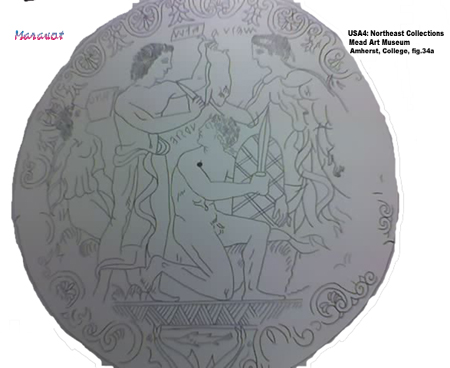 |
||||||||||||||||||||||||||||||||||||||||||||||||||||||
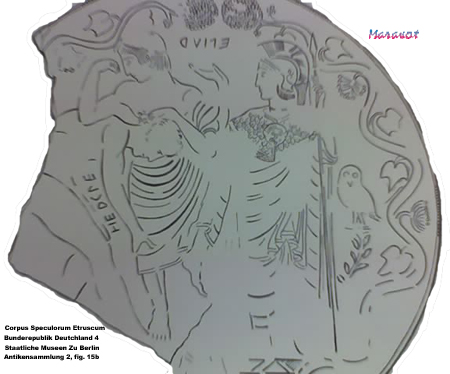 |
||||||||||||||||||||||||||||||||||||||||||||||||||||||
| CT
—
Corpus USA 4 N. E. Collections, fig. 34a,
Mead Art Museum, Amherst College, from
Orvieto, 1946. CT-1 METVA [Translation: Medea, daughter of King Aeetes, wife of Jason? CT-2 APLV [Translation: Apollo] CT-3 ORSTE (VRSTE) [Translation: CT-4 CANR or CANT [Translation: to prophesy, sing, celebrate (L. cano, canere, cecini, cantum)) Note: In this mirror Apollo appears to be sacrificing a pig over the head of Orestes, no doubt an act of purifying Orestes of murdering his mother and her lover. Medea had been responsible for the murder of her brother, by Jason, when escaping Colchis. She also purified Heracles of the murder of his children. Jason in Corinth later divorced her because she was not a citizen; she went to Athens, where the king, Aegeus, father of Theseus by the Trojan Aethra, married her and they bore a son Medus. Medus became the father of the Medes (of Persia). |
||||||||||||||||||||||||||||||||||||||||||||||||||||||
| CS
—
Corpus Bunderepublik Deutchland 4,
Staatliche Museen Zu Berlin, figure 15b.
Mirror with Heracles, Minerva and another
person. The owl and breastplate identifies
Minerva. EPIVR must refer to the other
person in the scene. CS-1 EPIVR [Translation:Ephyra? This may refer to Ephrya, a city in Thesprotia, ruled by King Phylas, who was often at war with Calydon. When Heracles led a Calydonian army against it, the city was destroyed, Phylas killed, and his daughter Astyoche carried off by Heracles as his concubine. She bore Tlepolemus by her abductor. Ephyra was later ruled by Ilus, a descendant of Medea and Jason, and the city became known as a source of poisons. Ilus was a pious person, however, and refused to sell poison to the young Odysseus. The image here shows Hercules picking up a young man in front of Minerva.] There is a similar name, EPE VR, of a small child raised in the palm of Heracles to Tinia, on the Divine_Mirror.html, Script DM. CS-2 HERCLE [Translation: Heracles] |
||||||||||||||||||||||||||||||||||||||||||||||||||||||
 |
||||||||||||||||||||||||||||||||||||||||||||||||||||||
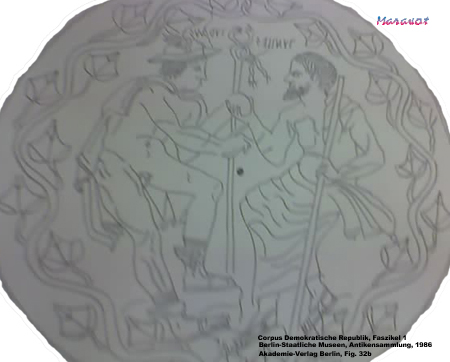 |
||||||||||||||||||||||||||||||||||||||||||||||||||||||
| CU
—
Deutche Demokratishche Republik, Faszikel I,
Berlin Staatliche Museum Antikensammlung,
1986, Akademie-Verlag, Berlin, Fig. 31b. CU-1 ATVNIS [Adonis] CU-2 EFAN [Euan, Dionysus, Bacchus] CU-3 MEAN [Mean, Diana, Artemis] Note that both Artemis and Mean are shown in mirrors and both are accompanied by deer, a symbol of the huntress goddess. All three are vegetation dieties and Adonis was worshipped in locations called "The Garden of Adonis." Adonis, a beautiful young man, was a son of Aphrodite according to some accounts and in most accounts met an early death, killed by a boar. The red anemone is said to have sprung up where he died, commemorating his blood. Mean is another name of Artemis, in Script DM, etc. |
||||||||||||||||||||||||||||||||||||||||||||||||||||||
| CV — Corpus Bunderepublik Deutchland 4,
Staatliche Museen Zu Berlin, Figure 32.b. CV-1 TVRMS [Translation: Hermes] CV-2 TVNTLES [Translation: Tyndareus] He is holding an egg in his hand before Hermes. He is also seen in CM-2 as TVNTLE. Note the declension. Latin 5th declension -e, sing. = ablative; -es, sing. = nominative. |
||||||||||||||||||||||||||||||||||||||||||||||||||||||
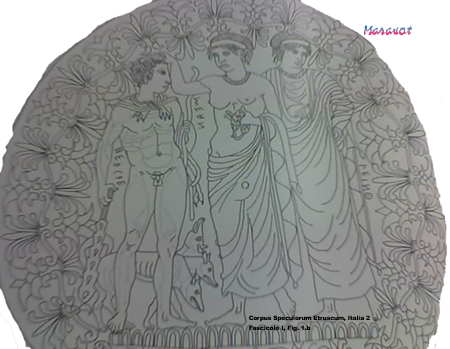 |
||||||||||||||||||||||||||||||||||||||||||||||||||||||
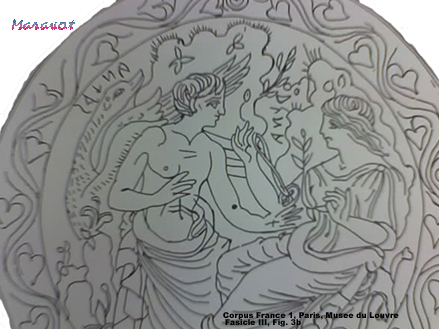 |
||||||||||||||||||||||||||||||||||||||||||||||||||||||
| Corpus
Italia 2, Fasciolo I, Bologna —
Museo Civico, "L'erma" di
Bretschneider–Roma, 1981: Fig. 1.b, Script
CZ, "Mean crowning Heracles." CZ-1 LEINTH or LEINR [Translation: Larentia] CZ-2 MEAN [Translation: Artemis, known by another name. Here she appears to be crowning Heracles and awarding him with Larentia.] CZ-3 HERCLE [Heracles] Note that LEINR is at CF-5. LEINTH appears to be Larentia who is an obscure Roman goddess worshipped in an annual festival, the Larentalia. She is said to have been the wife of Faustulus, the shepherd who reared Romulus and Remus. She was also believed to have been the "she-wolf" that suckled the children — lupa, carrying a double meaning, of a she-wolf and a prostitute. Larentia is connected with another story involving Heracle's temple at Rome, where the keeper had invited Heracles to a contest with dice, with the loser to give the winner a present. When the god won, the temple servant locked in the sanctuary, along with a sumptuous dinner, Larentia, the most beautiful prostitute in Rome. The god, after taking his fill, advised Larentia to court the next man she met. She did so and became the wife of a wealthy Etruscan who bequeathed to her all of his money. This money Larentia left in turn to the Roman people. |
||||||||||||||||||||||||||||||||||||||||||||||||||||||
| CX
—
Corpus France, Fasicule III, Musee du
Louvre, Figure 3b. CX-1 ANCHAS (AN CX-2 RALNA [Translation: Nemesis, the mother of Helen]. There are two versions to the rape of Nemesis by Zeus. Both stories refer to Zeus, as a swan, chasing Nemesis who had taken the form of a goose. The Etruscan version shown here agrees with the tale involving Aphrodite. Aphrodite had taken the form of an eagle and gave chase to the swan Zeus and Zeus took refuge in the lap of Nemesis (who retained her human form in this story). The goddess, apparently overcome with compassion, did not chase the bird away but, instead, went obligingly to sleep — subsequently to produce an egg containing Helen. The bird in this scene is presumably a swan. |
||||||||||||||||||||||||||||||||||||||||||||||||||||||
 |
||||||||||||||||||||||||||||||||||||||||||||||||||||||
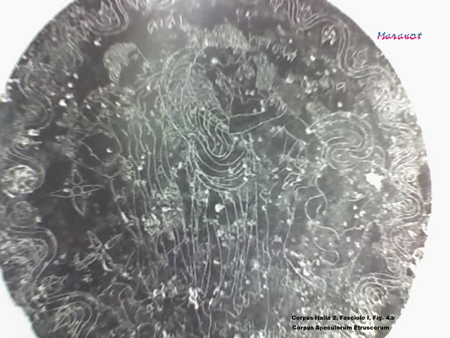 |
||||||||||||||||||||||||||||||||||||||||||||||||||||||
| Corpus
Italia 2, Fasciolo I, Bologna —
Museo Civico, "L'erma" di
Bretschneider–Roma, 1981: Fig. 3.b CAB-1 MENRFA [Minerva] CAB-2 AKRARE or AKRATHE [Translation: Agrius, one of the Giants.] In the war between Giants and gods, the Fates killed Agrius and his brother Thoas with brazen clubs. In this scene it is Minerva who attacks Akrare. |
||||||||||||||||||||||||||||||||||||||||||||||||||||||
|
Corpus Italia 2, Fasciolo I, Bologna — Museo Civico, "L'erma" di Bretschneider–Roma, 1981: Fig. 4.b, Script CAC CAC-1 TVRAN [Turan] CAC-2 LASA [Lasa, household goddess (L. lasa) CAC-3 ATVNIS [Adonis]  CCH-1 TIA, dea-ae, Abl. Sngl. deā, to the goddess, CCH-2, SVN, I celebrate, L. sono-are-ui-itum, L. Ind. 1st Pers. Sngl. sono, CCH-3 8V8LVNS, Dionysus, CCH-4 AVARA (A8AOA), to long for, desire, L. infinitive, avere CCH-5 CANTVS, L. cantus-us, singing, playing, music, prophecy, magic spell |
||||||||||||||||||||||||||||||||||||||||||||||||||||||
| Mirrors
not yet placed on this site: CY — Corpus France, Fasicule III, Musee du Louvre, Figure 2b. CY-1 EVPLE [ possibly Athamas, a king of Orchomenus, also called Euippe. He was the unluckiest man in the world and brother of Sisyphus.] CY-2 MENRFA [Translation Minerva] |
||||||||||||||||||||||||||||||||||||||||||||||||||||||
Notes:
* Corpus Speculorum Etruscorum, a multivolume
work. Copies I examined are in the University of
California Library, catalogued in the Pathfinder UCB Library Catalogue.
Volumes used on this site are as indicated. The
mirrors selected on this site are the only ones
that I found containing text. About three of the
mirrors were identified as "modern," suspected of
being fakes. There text is not referred to in
"Etruscan Phrases."
**Mythology based upon Edward
Tripp's "The Meridian Handbook of Classical
Mythology," New American Library, 1970.
—Θ
Launched 02.16.07
Upadated:
2.17.07; 2.21.07; 5.23.09; 5.25.09; 7.24.09,
6.15.2022
Copyright
© 1981-2022 Maravot. All rights reserved.
Copyright © 1981-2022 Mel Copeland. All rights
reserved.